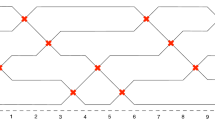Abstract
Non-dominated sorting arranges a set of points in n-dimensional Euclidean space into layers by repeatedly removing the coordinatewise minimal elements. It was recently shown that nondominated sorting of random points has a Hamilton–Jacobi equation continuum limit. The obvious numerical scheme for this PDE has a slow convergence rate of \(O(h^\frac{1}{n})\). In this paper, we introduce two new numerical schemes that have formal rates of O(h) and we prove the usual \(O(\sqrt{h})\) theoretical rates. We also present the results of numerical simulations illustrating the difference between the formal and theoretical rates.


Similar content being viewed by others
Notes
We say that \(u:\Omega \subset \mathbb {R}^n \rightarrow \mathbb {R}\) is nondecreasing if \(x_i \mapsto u(x)\) is nondecreasing for all i.
References
Bardi, M., Dolcetta, I.: Optimal Control and Viscosity Solutions of Hamilton–Jacobi–Bellman Equations. Springer, Berlin (1997)
Barles, G., Souganidis, P.E.: Convergence of approximation schemes for fully nonlinear second order equations. Asymptot. Anal. 4(3), 271–283 (1991)
Bollobás, B., Winkler, P.: The longest chain among random points in Euclidean space. Proc. Am. Math. Soc. 103(2), 347–353 (1988)
Calder, J.: Directed last passage percolation with discontinuous weights. J. Stat. Phys. 158(45), 903–949 (2015)
Calder, J., Esedoglu, S., Hero, A.O.: A Hamilton–Jacobi equation for the continuum limit of non-dominated sorting. SIAM J. Math. Anal. 46(1), 603–638 (2014)
Calder, J., Esedoglu, S., Hero, A.O.: A PDE-based approach to non-dominated sorting. SIAM J. Numer. Anal. 53(1), 82–104 (2015)
Crandall, M., Ishii, H., Lions, P.: User’s guide to viscosity solutions of second order partial differential equations. Bull. Am. Math. Soc. 27(1), 1–67 (1992)
Crandall, M.G., Lions, P.L.: Two approximations of solutions of Hamilton–Jacobi equations. Math. Comput. 43(167), 1–19 (1984)
Deb, K., Pratap, A., Agarwal, S., Meyarivan, T.: A fast and elitist multiobjective genetic algorithm: NSGA-II. IEEE Trans. Evolut. Comput. 6(2), 182–197 (2002)
Deckelnick, K., Elliott, C.M.: Uniqueness and error analysis for Hamilton–Jacobi equations with discontinuities. Interfaces Free Bound. 6(3), 329–349 (2004)
Deuschel, J.D., Zeitouni, O.: Limiting curves for i.i.d. records. Ann. Probab. 23(2), 852–878 (1995)
Felsner, S., Wernisch, L.: Maximum k-chains in planar point sets: combinatorial structure and algorithms. SIAM J. Comput. 28(1), 192–209 (1999)
Hammersley, J.: A few seedlings of research. Proc. Sixth Berkeley Symp. Math. Stat. Probab. 1, 345–394 (1972)
Hsiao, K.J., Calder, J., Hero III, A.O.: Pareto-depth for multiple-query image retrieval. IEEE Trans. Image Process. 24(2), 583–594 (2015)
Hsiao, K.J., Xu, K., Calder, J., Hero, A.: Multi-criteria anomaly detection using pareto depth analysis. Adv. Neural Inf. Process. Syst. 25, 854–862 (2012)
Hsiao, K.J., Xu, K., Calder, J., Hero III, A. O.: Multi-criteria similarity-based anomaly detection using pareto depth analysis. IEEE Trans. Neural Netw. Learning Syst. 27(6):1307–1321 (2016)
Prähofer, M., Spohn, H.: Universal distributions for growth processes in 1+1 dimensions and random matrices. Phys. Rev. Lett. 84(21), 4882–4885 (2000)
Sethian, J.A.: A fast marching level set method for monotonically advancing fronts. Proc. Natl. Acad. Sci. 93(4), 1591–1595 (1996)
Souganidis, P.E.: Approximation schemes for viscosity solutions of Hamilton–Jacobi equations. J. Differ. Equ. 59(1), 1–43 (1985)
Ulam, S. M.: Monte Carlo calculations in problems of mathematical physics. In Beckenbach E. F. (ed.) Modern Mathematics for the engineer. Second Series, McGraw-Hill, New York (1961)
Viennot, G.: Chain and antichain families, grids and Young tableaux. In: Orders: description and roles, North-Holland Mathematics Studies, vol. 99, pp. 409–463 (1984)
Zhao, H.: A fast sweeping method for Eikonal equations. Math. Comput. 74(250), 603–627 (2005)
Acknowledgements
The author is grateful to Selim Esedoḡlu and Lawrence C. Evans for valuable discussions about this work.
Author information
Authors and Affiliations
Corresponding author
Additional information
The research described in this paper was partially supported by NSF Grants DMS-1500829 and DMS-0914567. Part of this work was completed while the author was supported by a Rackham Predoctoral Fellowship.
A Properties of finite differences
A Properties of finite differences
We give the proof of Lemma 7 here.
Proof
We proceed by induction. The base case of \(N=2\) is exactly Proposition 1(ii). Assume (4.8) holds for some \(N\ge 2\). Then by the inductive hypothesis and base case
Notice that
where in the final summation, \(I \subset \{1,\dots ,N+1\}\). We also have
Combining this with (A.1) and (A.2) we have
This verifies (4.8) for \(N+1\). The proof is completed by mathematical induction. \(\square \)
Rights and permissions
About this article
Cite this article
Calder, J. Numerical schemes and rates of convergence for the Hamilton–Jacobi equation continuum limit of nondominated sorting. Numer. Math. 137, 819–856 (2017). https://doi.org/10.1007/s00211-017-0895-5
Received:
Published:
Issue Date:
DOI: https://doi.org/10.1007/s00211-017-0895-5




